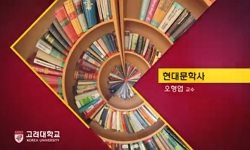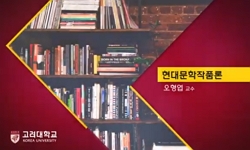The ecological study of literature could be defined as a cultural response to the socio-culture shock of the modern times. In this writing, based on the premise that the most dynamic and sharpest keyword for the contemporary aesthetics is the ecologic...
http://chineseinput.net/에서 pinyin(병음)방식으로 중국어를 변환할 수 있습니다.
변환된 중국어를 복사하여 사용하시면 됩니다.
- 中文 을 입력하시려면 zhongwen을 입력하시고 space를누르시면됩니다.
- 北京 을 입력하시려면 beijing을 입력하시고 space를 누르시면 됩니다.
https://www.riss.kr/link?id=A104141897
-
저자
신철하 (강원대학교)
- 발행기관
- 학술지명
- 권호사항
-
발행연도
2006
-
작성언어
Korean
-
주제어
ecological Literature ; double binding ; Bul-yeon-gi-yeon ; Yul- ryeo ; mbiguity ; Kim soo yeong ; Lee Mun Goo ; Kim ji ha ; 문학생태학 ; 이중구속 ; 不然其然 ; 律呂 ; 복잡성 ; 김수영 ; 이문구 ; 김지하
-
등재정보
KCI등재
-
자료형태
학술저널
-
수록면
441-476(36쪽)
-
KCI 피인용횟수
8
- 제공처
-
0
상세조회 -
0
다운로드
부가정보
다국어 초록 (Multilingual Abstract)
Kim Su Young is such a poet who successfully sublimated the expression of freedom by literature of which he had been pursuing continuously into ecological aesthetics. The abstruseness of the poems written by Kim Su Young should be defined as another expression of ambiguity, whichis the essence of life to the author. His language closely approaches the essence of ecology, of which the indigenous language contains. This effort stands against the issue on the “speed” of the modern literature, but at the same time, it is filled with the ecological rules of composition. On the other hand, the most meaningful and important issue of Kim Ji Ha’s definition of life could be compressed to a word, ‘Yul-ryeo’. Yul-ryeo, a form of cultural movement and practice of culture, introduces the Copernican revolution about modern understanding of life to the people of the same age.
In conclusion, the ultimate objects of this writing through concrete construction of the texts are the ecological leap and dimensional qualitative change.
Keyword : ecological Literature, double binding, Bul-yeon-gi-yeon, Yul- ryeo, mbiguity, Kim soo yeong, Lee Mun Goo, Kim ji ha
The ecological study of literature could be defined as a cultural response to the socio-culture shock of the modern times. In this writing, based on the premise that the most dynamic and sharpest keyword for the contemporary aesthetics is the ecological ground, the writer carefully tries to analyze and explain three texts which are believed to be formulating the aesthetic hierarchy of the above. The core of that explanation is composed of ‘double-binding’ and ‘Bul-yeon-gi-yeon’.
Kim Su Young is such a poet who successfully sublimated the expression of freedom by literature of which he had been pursuing continuously into ecological aesthetics. The abstruseness of the poems written by Kim Su Young should be defined as another expression of ambiguity, whichis the essence of life to the author. His language closely approaches the essence of ecology, of which the indigenous language contains. This effort stands against the issue on the “speed” of the modern literature, but at the same time, it is filled with the ecological rules of composition. On the other hand, the most meaningful and important issue of Kim Ji Ha’s definition of life could be compressed to a word, ‘Yul-ryeo’. Yul-ryeo, a form of cultural movement and practice of culture, introduces the Copernican revolution about modern understanding of life to the people of the same age.
In conclusion, the ultimate objects of this writing through concrete construction of the texts are the ecological leap and dimensional qualitative change.
Keyword : ecological Literature, double binding, Bul-yeon-gi-yeon, Yul- ryeo, mbiguity, Kim soo yeong, Lee Mun Goo, Kim ji ha
국문 초록 (Abstract)
문학생태학은 탈(후기) 근대의 사회문화적 충격에 대한 문학적 반응이다. 이 글은 동시대 미학의 가장 첨예하고도 역동적인 키워드가 생태적 사유라는 전제를 통해, 그것의 미학적 위계를 ...
문학생태학은 탈(후기) 근대의 사회문화적 충격에 대한 문학적 반응이다. 이 글은 동시대 미학의 가장 첨예하고도 역동적인 키워드가 생태적 사유라는 전제를 통해, 그것의 미학적 위계를 정치하게 형식화하고 있다고 판단되는 세 개의 텍스트를 면밀하게 분석하고 해석한다. 그 해석의 핵을 이루는 것은 이중구속론과double binding 不然其然Bulyeongiyeon이다. 김수영은 그가 추구한 자유의 문학적 실천을 가장 높은 단계의 생태학적 미학으로 승화한 시인이다. 그가 시도한 언어적 난해성은 그런 의미에서 애매성ambiguity의 다른 표현이며, 그것이 김수영적 생명론의 본질이다. 이문구의 언어는 토착어가 함유하고 있는 생태학적 본질에 다가가고자 노력한다. 그 노력은 근대적 속도에 길항(拮抗)하면서 그것을 뛰어넘으려는 생태적 문법으로 충만 해 있다. 한편, 김지하의 생명론이 표상하는 화두는 율려Yul-ryeo로 압축된다. 문화운동이자 문학적 실천이기도 한 그것은 동시대인들에게 근대적 생명관에 대한 코페르니쿠스적 전회(轉回)를 설득한다.그리하여 구체적 텍스트 해석을 관통하면서 이 글이 노리는 것은 궁극적으로 생태담론 논의의 비약적 도약과 차원의 질적 전화(轉化)이다. SUMMARY
참고문헌 (Reference)
1 "흰 그늘의 길" 학고재 2003
2 "중심의 괴로움" 솔 1996
3 "인문학과 생태학" 백의 2001
4 "우리시와 생태현실주의" 천년의시작 (15호) : 2005
5 "예감에 가득 찬 숲 그늘" 실천문학사 1999
6 "생태학의 담론" 솔 1999
7 "생태시학으로서의 생명과 율려" 한국어문연구회 127집 : 2005
8 "생태문학의 정의와 분류를 위한 하나의 시도" 독일언문학연구회 (12호) : 1999
9 "생명과 자치" 솔 1996
10 "삶과 온 생명" 솔 1998
1 "흰 그늘의 길" 학고재 2003
2 "중심의 괴로움" 솔 1996
3 "인문학과 생태학" 백의 2001
4 "우리시와 생태현실주의" 천년의시작 (15호) : 2005
5 "예감에 가득 찬 숲 그늘" 실천문학사 1999
6 "생태학의 담론" 솔 1999
7 "생태시학으로서의 생명과 율려" 한국어문연구회 127집 : 2005
8 "생태문학의 정의와 분류를 위한 하나의 시도" 독일언문학연구회 (12호) : 1999
9 "생명과 자치" 솔 1996
10 "삶과 온 생명" 솔 1998
11 "살림의 시학" 세계사 1995
12 "문학생태학의 미학적 과제" 한국언어문학회 51집 : 2003
13 "문학, 생태학, 현실" 중앙일보사 (통권92호) : 2000
14 "마음의 생태학" 1989
15 "김수영시와 자유" 한국언어문학회 54집 : 2005
16 "기우뚱한 균형에 관하여" 환경운동연합 (26) : 1995
17 "경계의 시학" 민음사 (통권4호) : 1997
18 "What is Life" 한울 2001
19 "The Resistance to theory" 한신문화사 1993
20 "Les trois cologies" 동문선 2003
21 "Kali for Woman" 1988
22 "Ecology and End of Postmodernity" icon books Ltd, london 2001
23 "Ancient Futures: Learning From Ladakh" 녹색평론사 1997
동일학술지(권/호) 다른 논문
-
- 상허학회
- 이종대
- 2006
- KCI등재
-
식민지 근대의 내면과 표상- 이광수의 『무정』을 중심으로
- 상허학회
- 김영찬
- 2006
- KCI등재
-
잡지 만화와 만평으로 본 여성 - 작가 의식을 통한 식민지적 근대를 중심으로
- 상허학회
- 이명희
- 2006
- KCI등재
-
- 상허학회
- 이은주
- 2006
- KCI등재
분석정보
인용정보 인용지수 설명보기
학술지 이력
| 연월일 | 이력구분 | 이력상세 | 등재구분 |
|---|---|---|---|
| 2027 | 평가예정 | 재인증평가 신청대상 (재인증) | |
| 2021-01-01 | 평가 | 등재학술지 유지 (재인증) |  |
| 2020-03-12 | 학회명변경 | 영문명 : Sanghur Hakbo-The Jounal Of Korean Modern Literature -> The Learned Society of Sanghur’s Literature |  |
| 2020-03-11 | 학술지명변경 | 외국어명 : The Leaned Society of sanghur`s Literature -> Sanghur Hakbo: The Journal of Korean Modern Literature |  |
| 2018-01-01 | 평가 | 등재학술지 유지 (등재유지) |  |
| 2015-01-01 | 평가 | 등재학술지 유지 (등재유지) |  |
| 2011-01-01 | 평가 | 등재학술지 유지 (등재유지) |  |
| 2009-01-01 | 평가 | 등재학술지 유지 (등재유지) |  |
| 2007-01-01 | 평가 | 등재학술지 유지 (등재유지) |  |
| 2004-01-01 | 평가 | 등재학술지 선정 (등재후보2차) |  |
| 2003-01-01 | 평가 | 등재후보 1차 PASS (등재후보1차) |  |
| 2001-07-01 | 평가 | 등재후보학술지 선정 (신규평가) |  |
학술지 인용정보
| 기준연도 | WOS-KCI 통합IF(2년) | KCIF(2년) | KCIF(3년) |
|---|---|---|---|
| 2016 | 1.14 | 1.14 | 1.17 |
| KCIF(4년) | KCIF(5년) | 중심성지수(3년) | 즉시성지수 |
| 1.25 | 1.21 | 2.23 | 0.97 |




 RISS
RISS






